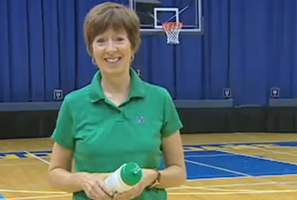The quest for sustainable energy and resource use has been called the preeminent challenge of the 21st century. First year students at Notre Dame get a taste of the issues involved and how they can make a difference during the required First Year seminar, Contemporary Topics.
The curriculum materials consist of a 6-page section of the Contemporary Topics textbook written in comic strip format and a 9-minute video featuring a diverse array of Notre Dame luminaries, ranging from Fr. Theodore Hesburgh to Muffet McGraw.
“We didn’t want sustainability to be just another lesson to get through, and that’s why we worked so hard to create engaging materials,” said Rachel Novick, Education and Outreach Program Manager in the Office of Sustainability. “I collaborated with a large group of students in order to make sure that we were being relevant to student life at Notre Dame.”
Student response to the curriculum has been very positive. Asked what was their favorite part of the video, most First Years respond, “the part with the football players”. They are referring to a scene in which two players get motivated at football practice by imagining someone who’s not recycling. As Coach Mike Denbrock explains, “That gets them really mad.”
Both the comic strip and the video feature powerful statistics about the importance of pursuing a more sustainable lifestyle. “The majority of the featured facts were surprising to me,” said John Kriegshauser ’15, “particularly the one regarding the amount of power saved by recycling just one [aluminum] can.” (That’s enough energy to power a TV for three hours.)
“Many of my students have felt inspired to go beyond the basics of recycling a can or unplugging the TV to exploring how they can make an impact globally,” said Marisha Schmidt, who coordinates the Contemporary Topics program. “It’s always the hope of an educator that awareness of an issue will create a doorway of opportunity somewhere in the future. The excitement, questions, and referrals from this material have more than exceeded those expectations.”
In addition to promoting practical behaviors that conserve energy and resources, the video also communicates the social justice implications of sustainability and the profound connections between care for the environment and Notre Dame’s Catholic mission.
“I can look out my window and see beauty, and I hope that the next fellow that comes along can see the same kind of beauty, even something more beautiful,” comments Fr. Hesburgh, renowned President Emeritus of Notre Dame. “And we have to educate our students, I think, in the fact that they are responsible for maintaining the beautiful world that God gave us and to do all the things that they can in their lives to sustain the beauty of this world.”
“The part about [an average American] using as much energy in 3 months as a Ugandan does in his whole lifetime was staggering,” said Duncan Campbell ’15. “It makes me think about how well-off I am, as well as how wasteful I am.”
Fr. John Jenkins, Notre Dame’s President, sums it up beautifully: “The responsibility to sustainability arises from a call to promote justice, because the poor suffer most from environmental degradation,” says Fr. Jenkins. “It comes from a call to foster peace, as conflicts over scare natural resources are becoming ever more common. And it comes from a call to act on behalf of those not yet born, for their quality of life tomorrow depends on the choices we make today.”
The success of the sustainability curriculum in Contemporary Topics will be measured, in part, by behavior change in the Notre Dame student population, which has become increasingly eco-friendly over the last several years. “I’ve been more conscious of some decisions regarding electronics and the dining hall experience,” said Krieghauser. “I will definitely recycle all that I can,” added Campbell.
“Students are now exposed to these issues during their freshman year at Notre Dame, and once their interest is peaked, they have plenty of opportunities to pursue the topic further,” concluded Novick. “They can now minor in Sustainability or Energy Studies, take a class, or engage in research with a faculty member. There are so many ways to learn more.”
